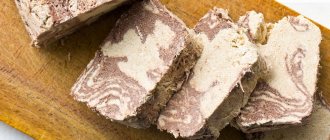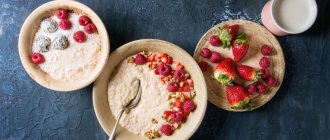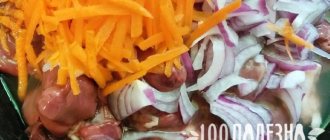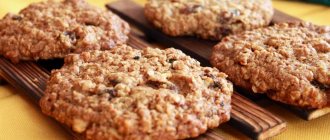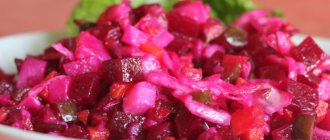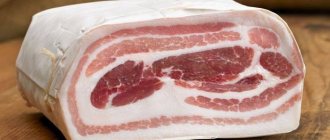Calorie content and chemical composition
There are more than 100 varieties of halva, but traditionally, the first place is occupied by sunflower, second by nut, third by tahini and sesame (purely oriental options). The chemical composition and calorie content of the species differ, which is explained by the variety of raw materials.
| Index | Sunflower | Nut (peanut) | Tahini | Sesame |
| Calorie content per 100 g | 516 | 490 | 507 | 470 |
| Proteins, g | 11,7 | 16,8 | 13,2 | 11,9 |
| Fats, g | 29,8 | 27,9 | 31,1 | 28,7 |
| Carbohydrates, g | 55 | 46,3 | 50,5 | 44,5 |
| Vitamins, mg | ||||
| Ascorbic acid | 3,2 | 4,3 | 5,5 | 4,7 |
| A nicotinic acid | 6,4 | 6,2 | 6,7 | 6,8 |
| Tocopherol | 17,8 | 19,9 | 22,9 | 21,2 |
| Thiamine | 0,9 | 0,8 | 0,8 | 0,8 |
| Riboflavin | 0,1 | 0,1 | 0,12 | 0,11 |
| Retinol | 0,1 | 0,1 | 0,13 | 0,11 |
| Minerals, mg | ||||
| Potassium | 352 | 432 | 275 | 312 |
| Magnesium | 189 | 168 | 304 | 239 |
| Calcium | 311 | 465 | 1500 | 1356 |
| Phosphorus | 298 | 367 | 401 | 345 |
| Sodium | 89 | 57 | 40 | 41 |
| Iron | 31,2 | 29,5 | 49,2 | 45,8 |
What is the calorie content of the product?
Knowing what oriental sweets are made from, it is easy to calculate its calorie content. In the East it is made by hand, and therefore the energy value is 410-420 kcal per 100 grams. This figure is significantly lower than that of a product manufactured in industrial conditions (its energy value is 570 kcal per 100 grams).
The calorie content of halva, especially sunflower halva, prepared using conventional technologies, is high. Moreover, it can increase when adding more sugar or increasing the raw fat content.
Different types - different calorie content
Nowadays, there are three main types of this sweet that are most often found:
- sunflower;
- sesame (tahini);
- peanut.
As already mentioned, sunflower sweetness has the highest energy value (on average 540 kilocalories per 100 grams). It contains a large amount of vegetable fats and a considerable proportion of vitamins PP and B1.
Therefore, it is recommended for use by people who have problems with blood vessels, heart or weak nervous system. Moreover, the nicotinic acid contained in sunflower halva normalizes cholesterol levels, and is also responsible for the immune system and blood circulation. It turns out that sunflower halva is the most valuable product, even taking into account the fact that it has high nutritional value.
Sesame halva has a lower energy value, approximately 450 kilocalories per 100 grams. Sesame seeds are capable of burning fats and removing toxins and other harmful substances from the body. Consequently, halva made from it can do the same. It is rich in microelements, vitamins and minerals. Vitamins from group E deserve special attention.
They help blood clot and promote the dilation of blood vessels, and this reduces the risk of atherosclerosis. Sesame halva includes a number of elements: manganese, magnesium, zinc, calcium and vitamins from group B. Due to them, the heart muscle is strengthened and blood vessels are normalized.
Peanut oriental sweetness contains just over 500 kcal. A large portion of folic acid in peanut halwa improves brain function. Fatigue and psychological stress are also reduced. Calcium and zinc in peanut halva strengthen teeth, hair and bones and are involved in skin rejuvenation. All the beneficial properties and calorie content in peanut halva balance each other.
Beneficial features
The calorie content of halva is high, but if you consume it in moderation - no more than 30 g per day, then such a dose will not cause much harm to your figure and health. It is noteworthy that each type of halva has its own beneficial properties.
For example, pistachio is especially recommended for use by athletes, as it relaxes muscles and helps restore strength after intense training. Sesame is a natural aphrodisiac, chocolate (glazed) is a powerful antidepressant. All types of oriental sweets also have common beneficial properties:
- Increases the level of hemoglobin in the blood, which is explained by the increased content of iron.
- A large amount of vitamins allows the body to partially compensate for the deficiency of these substances.
- It has a calming effect on the nerves, so much so that it can take on the function of a weak sleeping pill.
- It has a beneficial effect on the heart because it contains potassium and magnesium.
- Helps normalize blood pressure.
- Stops the growth of tumors (both malignant and benign).
- Recommended for use by people engaged in mental work, because it contains glucose and PUFAs necessary to nourish the brain.
- Strengthens intestinal motility and helps eliminate congestion.
- It has a positive effect on the reproductive organs (both male and female) due to the content of folic acid.
- In terms of protein composition, halva is close to meat, therefore, it is a valuable source of amino acids.
- Strengthens the body after long-term illness and surgical interventions.
- Slows down the aging process.
The benefits of tahini delicacy
Sesame halva, the benefits and harms of which depend on the amount of delicacy consumed, is a source of vegetable fats, vitamins B, A, E, C, D and minerals.
The following beneficial properties of tahini are highlighted:
- improves intestinal motility and activity of the digestive system;
- replenishes the body’s energy reserves after hard physical labor, sports, and long hikes;
- strengthens hair, nails, skin, bone tissue;
- saturates the body with antioxidants;
- promotes the removal of free radicals;
- increases hemoglobin levels and improves the biochemical composition of the blood;
- has a beneficial effect on the psycho-emotional state;
- protects the body from vitamin deficiency.
In Middle Eastern countries, it is believed that sesame halva is not only a confectionery product, but also a natural rejuvenating agent. Moderate consumption of this product maintains a stable level of nutrients in the body necessary for the normal functioning of internal organs and systems.
Types of halva
Sunflower
It is most common, at least in Russian-speaking countries. This is not such an ancient product as its eastern “brothers”, because sunflower halva appeared in the 20th century. In addition to vitamins, minerals, PUFAs and protein, it contains phytosterol. This is a biologically valuable substance that removes excess cholesterol, prevents the appearance of atherosclerosis and effectively fights cancer cells. By the way, a deficiency of phytosterol in the body in men provokes the appearance of prostatitis.
Almond
A real delicacy, especially useful for pregnant women and those watching their figure. This is perhaps the lowest calorie variety, which is “poor in fat”, but rich in proteins, vitamin D, potassium and magnesium. The starting raw material is sweet almonds.
Peanut
It is worth paying attention to all women who care about their own health and appearance. This dessert contains a huge amount of “rejuvenating” substances, as well as valuable PUFAs, which help give the skin, nails and hair an absolutely luxurious look. The product has a creamy color and a dense structure, and inside it you can often find pieces of candied fruit (typical of the classic version).
Tahini (Persian)
To prepare it, use tahini paste, which is made from sesame seeds by thoroughly grinding. Tahini paste is a universal product, because it can be found in various appetizers and sauces that are so rich in oriental cuisine. Tahini halva has a somewhat unusual taste and is rich in beneficial substances that relieve headaches and have a positive effect on the respiratory system.
Sesame
Many people believe that tahini halva and sesame halva are two identical products. But this is actually not the case because no tahini paste is used for sesame halwa and this dessert consists entirely of roasted sesame seeds along with other ingredients. Sesame halva is inferior to tahini in a number of respects, but it is lower in calories and has identical beneficial properties.
Pistachio
It is possible that it is the most useful of all types of halva, because it contains a record amount of natural antioxidants, phosphorus and special substances that help neutralize lactic acid in the muscles. As you know, it is the formation of lactic acid that causes pain in the muscles after heavy physical exertion. Therefore, this product should be considered by bodybuilders, athletes and people engaged in heavy physical labor.
How much tahini halva can you eat per day?
In order to extract only beneficial properties from this oriental delicacy, and not to disrupt the functioning of the stomach, intestines, pancreas, liver and gall bladder, you should eat no more than 80-100 g of the sweet product per day.
This is the optimal amount of tahini, which will also not cause the development of an acute allergic reaction to sesame seeds. Practice shows that daily consumption of the specified amount of halva leads to saturation of the body with the product already on the 5-6th day.
National and local species
- Greek. Consists of walnuts, almonds, semolina, raisins, spices and olive oil.
- Tverskaya. Walnut-sunflower.
- Uzbek. There are several types - with pistachios, walnuts, with milk, with chocolate.
- Samarkand. It is prepared from whipped egg whites, ground into a paste of cashew nuts, cream, vanilla, and sugar. In the middle there is a cashew filling.
- Sheki. You can find cilantro and cardamom in the composition.
- Kokand. Prepared with cream, it contains a large number of “various” nuts and chocolate.
- Azovskaya. Made from sunflower seeds. This is a glazed dessert.
- Ingush. Contains cornmeal and walnuts.
- Chechen. It differs from Ingush only in the type of flour (wheat).
- Tajik. The structure contains caramel fibers.
- Indian. It is prepared with sweet carrots, bottle gourd, spices, nuts, flour, and juices.
- Turkish. Key ingredients: nut butter, sugar, honey.
- Tanzanian. Based on coconut milk.
Contraindications and harm
The main harm of halva is that it is too heavy for the digestive tract. If a person suffers from intestinal or stomach diseases, then dessert made from sunflower seeds should not be consumed. It can be replaced with peanut or sesame halwa. You can eat no more than 20 g per day.
The high calorie content of halva will lead to rapid weight gain. If you need to lose weight quickly, it is better to exclude it from your diet. People suffering from obesity should not eat the product more than twice a week. The rest can enjoy it every day, but do not exceed the recommended amount. Main contraindications for use :
- diabetes;
- allergic reactions;
- metabolic disease;
- last trimester of pregnancy;
- severe gastrointestinal diseases.
You should not eat stale halva as it can cause stomach upset. You should not give a lot of dessert to small children, as it can cause kidney problems and disturbances in the functioning of the nervous system.
Is it possible to eat halva with diabetes: benefits, harm, norm, home recipe
The benefits of halva during pregnancy and lactation
Almond halva will be especially useful for pregnant women; the product has a positive effect on the formation of several systems of the unborn child at once. If it is not possible to purchase this variety, you can use sunflower halva, which:
- promotes the normal course of pregnancy;
- has a positive effect on the digestive process;
- partially satisfies the body’s need for minerals and vitamins;
- normalizes oxygen metabolism;
- strengthens the heart.
You should not abuse this delicacy, especially in the later stages, as this will contribute to excess weight gain and the onset of diabetes. Nursing mothers can use the product with great caution, as it can cause allergies in the child.
Halva helps restore the body, relieves postpartum depression and helps increase the production of breast milk. But since it belongs to the category of “heavy” food, it is not recommended for women with gastrointestinal diseases to consume it.
In order not to harm your health and figure, you should familiarize yourself with the daily intake of halva: for children over 5 years old - 20-25 g, for those losing weight and pregnant women - no more than 30, for absolutely healthy people - no more than 50 g. Women who have passed the “Balzac age” should reduce the amount of calories they consume, and a “children’s” dose of 20-25 g is recommended.
Storing sesame halva
Homemade tahini delicacy is a perishable product. It is recommended to store the oriental sweetness in the refrigerator and consume it within 1-2 days. To prevent the product from spoiling, it should be prepared in small portions. For example, if no more than 300 g of sesame is used as a base, then on average you can make a dessert for 4 people.
Sesame halva is a confectionery product whose components are granulated sugar, caramel, molasses and sesame seeds. The homeland of this oriental delicacy is considered to be the territory of modern Iran.
The main benefit of tahini halva is its rich vitamin and mineral composition, positive effect on metabolism, saturation of the body with antioxidants and healthy oils of plant origin.
The harm of tahini is due to the fact that it contains a high concentration of sugar and fat. Eating large amounts of this sweetness creates additional stress on the pancreas, liver and intestines.
How to choose the right halva
Before purchasing halva in a store, you should carefully check whether the integrity of the packaging has been damaged. A product that is not hermetically packaged loses a lot in quality because oxygen accelerates the oxidation process of fats, causing them to go rancid.
A high-quality product does not have any stains on the surface, including oil stains. There should be no foreign inclusions inside or on the break in the form of husks or caramel veins. When cutting a product with a knife, it should not crumble, and wrinkled edges are the first sign that the manufacturer has introduced cheap substitutes into the recipe. Only sesame halva has a bitter taste, while sunflower halva has a fibrous-layered structure.
Compound
The main components of tahini delicacy are the following ingredients:
- sesame seeds, which undergo mechanical processing to grind to a homogeneous mass;
- molasses or caramel made from sugar;
- foaming agent
Depending on the technological method of preparing halva, its composition may include additives such as lecithin, cereal flour, vanillin, legumes, nuts, and ascorbic acid. The latter substance acts as a safe stabilizer of the chemical composition of halva, and also acts as a natural preservative.
The presence of excessive amounts of food additives can negatively affect the real taste of sesame halwa.
How to prepare halva at home
The most accessible ingredient (and common) is sunflower seeds. If desired, they can be replaced with sesame seeds or peanuts. The recipe for making homemade halva is simple, and you will need:
- Unpeeled, roasted seeds or peanuts - 4 tbsp.
- Wheat flour – 2 tbsp.
- Sugar – 10 tbsp. l.
- Water – 1.5 -2 tbsp.
- Vegetable oil – 1 tbsp. l.
Using a meat grinder, grind the roasted unpeeled seeds. Fry the flour in a dry frying pan until dark golden brown, and mix it with the resulting mass in a suitable bowl. Boil water in a saucepan, pour oil into it and add sugar.
The task is to cook the syrup, which is done over low heat, with constant stirring. Cooking time – 15 minutes. Afterwards, you need to carefully pour the syrup into the prepared mass and mix thoroughly. Wrap the resulting mixture in cellophane and put it in the refrigerator for a couple of hours.
A little about the benefits of halva
The high content of fats and vitamin E has a beneficial effect on the condition of the skin, hair, and nails. Quick digestibility, valuable protein, natural oils, protection against cancer - the advantages of halva can be listed endlessly.
Compound. Content of vitamins, micro and macroelements in halva
In 100 gr. The product contains vitamins:
- B1 – 0.48 mg,
- B2 – 0.11 mg,
- RR – 7.4 mg,
- E – 2.9 mg.
As you can see, halva contains a large amount of vitamin E and PP.
There are also a lot of microelements in sweets:
- Potassium – 316 mg,
- Calcium – 466 mg,
- Magnesium – 243 mg,
- Sodium – 75 mg,
- Phosphorus – 329 mg.
A huge dose of potassium, magnesium, calcium and phosphorus is the key to excellent health for people who consume halva as a dessert.
Contraindications
If you are overweight, have an individual intolerance to ingredients, or have a number of diseases, you should avoid eating halva. First of all, this applies to people suffering from:
- acute pancreatitis;
- obesity;
- diabetes mellitus;
- diathesis;
- caries;
- urolithiasis;
- liver pathologies.
Oriental sweets eaten in large quantities will not bring any benefit to the body, since this product contains a lot of fat and sucrose. Also, some manufacturers introduce not very healthy additives into their products, for example, molasses and flavor enhancers.
Harm of sunflower halva
Undoubtedly, like any other product, sunflower dessert has its drawbacks. Firstly, the calorie content of the treat is taken into account. Therefore, sunflower halva (and any other type of halva) is contraindicated for obese people following a strict weight loss diet. Secondly, both seeds and any other additives (raisins, nuts) are allergenic products. Therefore, food allergies can also be considered a contraindication.
Doctors do not recommend consuming sweets in case of the following pathologies:
- Diabetes;
- Pancreatitis;
- Cholecystitis;
- Cholelithiasis;
- Stones in the kidneys;
- Period of exacerbation of gastrointestinal diseases;
- Individual intolerance to the components of the product.
Halva also causes harm if a low-quality product is consumed. Unscrupulous manufacturers use cheap raw materials as the basis for halva. So, old seeds contain cadmium in their composition. Consequently, a person runs the risk of severe food poisoning and intoxication. You should also be wary of various GMOs and palm oil in the composition of the treat.
Question answer
Is it possible to eat halva if you have type 2 diabetes? Recipes for several types of halva have been developed for diabetics, and all of them are made using sweeteners. A regular product sold in a store is prohibited for use by persons suffering from diabetes, regardless of its type.
Is it possible to eat halva with pancreatitis? If the disease is in the acute stage, then this product is completely excluded from the diet. In the chronic form and in remission, the daily dose of oriental sweets should not exceed 20 g.
Is sunflower halva good for weight loss? A complete refusal of sweets provokes eating and nervous breakdowns. When losing weight, it is better to eat halva prepared independently, consisting of honey, fructose, sunflower seeds and flax. Daily dose – maximum 30 g.
What does fresh halva look like? Selection rules
To purchase natural and fresh halva made from sesame seeds, you must follow the following rules:
- choose only white halva with a slight grayish tint;
- buy an oriental delicacy without additional additives in the form of coconut, vanillin, cinnamon, as they clog its real taste and aroma;
- tahini halva should smell like fresh vegetable oil, and the smell of rot indicates that the product is made from low-quality sesame seeds;
- pay attention to the fact that the halva does not contain artificial sweeteners, which are used to reduce the cost of the product;
- the confectionery product must have a homogeneous mass without lumps or voids;
- You should buy loose halva, and not one that is packaged in closed packages (this way the consumer gets the opportunity to visually examine the sweetness, smell it, and detect external characteristics that do not meet food standards).
Tahini halva is a product that loses its taste if stored in rooms with elevated temperatures. Therefore, you should also pay attention to how this oriental sweet is stored.
How not to make a mistake when choosing halva?
There are a few simple tips that will help you purchase a fresh, healthy product that will benefit your health:
1) The packaging is not damaged and sealed
2) There is no oil or dark spots on the surface of the halva
3) Halva does not crumble when cut and retains its shape
4) There are no caramel veins, husks or uncrushed grains in the halva
5) The shape of the halva is even, the edges are the same
6) Halva looks dry and does not taste bitter
7) The expiration date corresponds to the stated period on the label
Halva is easy to make at home. To do this you will need thick caramel syrup, peanut seeds, raisins, and nuts. Boil the caramel syrup, beat with a mixer until foamy, chop the nuts well and add them to the resulting mass. Leave for a while and enjoy the taste later!
Halva is a sweet that reduces appetite and improves mood! Halva is not only a dessert, but also a wonderful snack between lunch and dinner.
Eat, enjoy and be healthy!
Halva is prepared using nuts, various seeds and sugar. This sweetness is very common around the world, because, unlike other confectionery products, it has benefits for the body. A distinctive feature of halva is that it contains up to 30% vegetable fats and has absolutely no cholesterol.
Types of halva
Basically, halva is made from nuts and oil seeds. The following varieties are found:
- Tahini. Prepared from ground sesame seeds.
- Sunflower.
Ground sunflower seeds are used. - Peanut
. It is prepared from ground peanuts, sometimes with the addition of sesame seeds and honey. - Nut
. A wide variety of nuts are used for cooking: pistachios, walnuts, almonds, cashews, etc.
There are also variants of halva with a different base: vegetables, milk, cotton candy, flour. As a rule, such halva is an addition to any national dish.
Benefits of halva
- Halva saturates the body with vitamin
E. This vitamin is an antioxidant and prevents the death and aging of body cells. It is best known as the “reproduction vitamin”, as it has a beneficial effect on the fertile functions of both men and women. - In addition, halva contains vitamins B1 and F1
, which stabilize the state of the nervous and cardiovascular systems, normalize cholesterol levels in the blood and help improve the condition of the skin and hair. - Halva contains many useful macro- and microelements
(potassium, phosphorus, magnesium, iron), dietary fiber, protein, and polyunsaturated fatty acids. All this allows you to improve your body’s health and keep it in good shape.
The nutritional value of halva is undeniable, especially considering that it can be stored for a long time
without losing the beneficial qualities of the product.
Calorie content of halva
Although halva has many advantages, it should be remembered that it is a very high-calorie product:
Due to its high calorie content, it is better to avoid this oriental sweet for people who are overweight, as well as those suffering from diabetes and metabolic disorders. In addition, sunflower seeds, peanuts, sesame and other nuts are allergens, so halva can provoke an allergic reaction.
Halva is ideal for drinking with tea. It has a crumbly consistency, a unique taste, and a pleasant aroma. These characteristics have won many people over to their side. Hence the question becomes relevant, which affects the benefits and harms of halva. Let's talk about everything in more detail.
Calories in halva and the struggle for a figure
Of course, traditional medicine recommends that those who are overweight avoid any type of product. There are a lot of calories in halva, and even a small portion can completely negate a restrictive diet. A few bites of sweets may provide more nutritional value than a standard lunch or dinner. However, some nutritionists are now considering halva as a component of a weight loss diet. The calorie content of halva is very high, but its property is also the ability to suppress appetite for a long time. After 30 grams of halva, many feel so full that they are ready to give up dinner altogether. If other ways to lose weight don't seem too attractive to you, then try losing weight with a halva-based diet. You can eat 200 grams of the product per day. The calorie content of halva in this quantity is approximately 1000-1050 kilocalories. In addition to sweets, you can eat an unlimited amount of raw vegetables (cucumbers, tomatoes, cabbage) per day. Thirst should be quenched with unsweetened tea or drinking water. You can eat according to this system for about 3 days without harm to your health. The calorie content of halva with such a diet will not harm your figure. Due to the fact that this confectionery product is excessively rich in sugar and fat, hunger is almost not felt during such a diet.
Halva is a famous oriental sweet. In fact, there are several types of this confectionery product. How many calories are in halva? It all depends on the composition of the product and its quantity. On the one hand, nutritionists are categorically against this sweetness, on the other hand, there are diets for losing weight with the help of halva. Are the calories in halva dangerous for your figure? Let's try to figure it out in this article.
Halva for children: good or bad
Halva is a product made from natural ingredients. Therefore, it will not cause any harm to the child’s body. The nuts in halva are rich in vitamins A, B and E. And they, in turn, are necessary to strengthen the immune system, preserve vision and maintain the proper functioning of the cardiovascular system. It is better for children under 5-6 years old to refrain from eating sweets. Pieces of sweets can injure the oral cavity, get stuck in the teeth and lead to caries. In addition, it is easy to choke on.
Children over 6 years old can add halva to their diet, but be sure to monitor the dosage - 10-15 g per day. The composition of halva must contain exclusively natural ingredients without vegetable fats and preservatives. Check to see if your baby has a nut or seed allergy. It is important that it is better not to give sunflower halva to children, since the heavy metal contained in sunflower seeds affects the central nervous system.
When getting your child ready for school, instead of confectionery sweets, you can put a piece of halva in his bag. The child will be refreshed, active and won’t go hungry for a long time! Halva will definitely become an essential component of your child’s afternoon snack along with a glass of milk or a cup of tea. However, you should not give your child halva every day. Today - wafer sweets, tomorrow - marmalade, the day after tomorrow - halva. It is best not to exceed the norm once a week.
